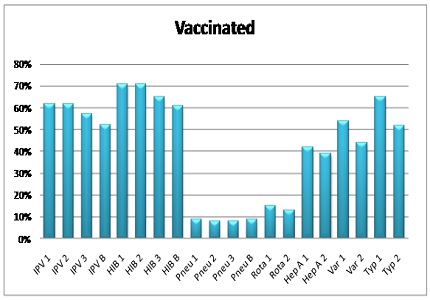Factors influencing acceptance of optional vaccines in children
Abstract
Introduction: Immunization has been one of the most significant, cost-effective and stimulatory public health intervention. Vaccines are among the most effective preventive health measures in reducing child mortality, morbidity, and disability. With the rapid growth of big cities, an impending threat of outbreak of vaccine-preventable diseases always exists. It is due to the high population density, continuous influx of a new pool of infective agents with the immigrating population and poor coverage of primary immunization. Vaccinations are best ways to end the serious effects of certain diseases.
Methods: A pre-tested structured questionnaire was used to elicit the information like the knowledge of parents on optional vaccines, various socio-demographic factors, about the immunization status and reasons for vaccinating and not vaccinating the child. The method used for the determination of the vaccination status was the vaccination card and the recall method.
Results: Of the total 400 children, 3% are fully immunized and 14% are unimmunized. Majority of parents has the knowledge about Typhoid vaccine. Over all vaccination rate was decreased with subsequent doses. Common reasons for vaccination are healthy child, prevents disease, disability and increase life expectancy. Most parents say lack of knowledge is the reason for not vaccinating the child. Most unimmunized children belong to families with ≥4 children, rural background, illiterate parents and low socioeconomic status.
Conclusions: Study noticed significant association of parental education, socioeconomic status, rural background, number of children in the family and gender discrimination along with unawareness of the parents as main reasons for low immunization coverage.
Downloads
References
2. Omer SB, Salmon DA, Orenstein WA, deHart P, Halsey N. Vaccine Refusal, Mandatory Immunization, and the Risks of Vaccine-Preventable Diseases. N Engl J Med 2009; 360:1981-1988.doi: 10.1056/NEJMsa0806477.
3. Nyarko P, Pence B, Debpuur C. Immunization status and child survival in rural Ghana. Population Research Division Working Paper No. 147, Population Council, New York 2001:29.
4. Lodha R, Dash NR, Kapil A, Kabra SK. Diphtheria in urban slums in north India. Lancet. 2000 Jan 15;355(9199):204. [PubMed]
5. Loening WE, Coovadia HM. Age specific occurrence rates of measles in urban, peri-urban and rural environment: Implications for time of vaccination. Lancet 1983; 2(8345):324-6.doi: 10.1016/S0140-6736(83)90299-4.
6. Bawah AA, Phillips JF, Adjuik M, Vaughan-Smith M, Macleod B, Binka FN. The impact of immunization on the association between poverty and child survival: evidence from Kassena-Nankana District of northern Ghana. Scand J Public Health. 2010 Feb;38(1):95-103. doi: 10.1177/1403494809352532. Epub 2009 Nov 2.
7. Vijay Yewale, Panna Choudhury, Naveen Thacker. IAP Guidebook on Immunization 2009-2011, 2011;pp 47-113, 162-167.
8. Nirupam S. UIP in Sarojini Nagar block of Lucknow district. Indian J Comm Med 1991:16(2): 82-4.
9. Malinikar. Primary Immunization Status of Children in Slum Areas of South Delhi - The Challenge of Reaching the Urban Poor, Indian J Comm Med.2001;26(3):151-154.
10. Bhatia V, Swami HM, Rai SR, Gulati S, Verma A, Parashar A, Kumari R. Immunization status in children. Indian J Pediatr. 2004 Apr;71(4):313-5.
11. Yadav J, Singh P. Immunization Status of Children and Mothers in the State of Madhya Pradesh. Indian J Comm Med 2004; 29(3):147-148.
12. Bashir Gaash, RohiniBhan, Shabnam Bashir. Immunization Status of Infants in a Remote District of Kashmir.Ind J Practic Doct 2004; 1(3): 11-12.
13. Singh P, Yadav R.J. Immunization status of children of India. Indian Pediatr 2000; 37: 1194-1199. [PubMed]
14. Singh P, Yadav RJ , Immunization status of children in BIMARU States Indian J Pediatr 2001; 68(6): 495-499. [PubMed]
15. Dalal A, Silveira MP. Immunization status of children in Goa. Indian Pediatr. 2005 Apr;42(4):401-2. [PubMed]
16. Chhabra P, Nair P, Gupta A, Sandhir M, Kannan AT. Immunization in urbanized villages of Delhi. Indian J Pediatr. 2007 Feb;74(2):131-4. [PubMed]
17. Williams IT, Milton JD, James BF, Neil M.H.G. Interaction of socioeconomic status and provider practices as predictors of immunization coverage in Virginia children. Pediatrics 1995;96:439-446.

Copyright (c) 2018 Author (s). Published by Siddharth Health Research and Social Welfare Society

This work is licensed under a Creative Commons Attribution 4.0 International License.


 OAI - Open Archives Initiative
OAI - Open Archives Initiative


